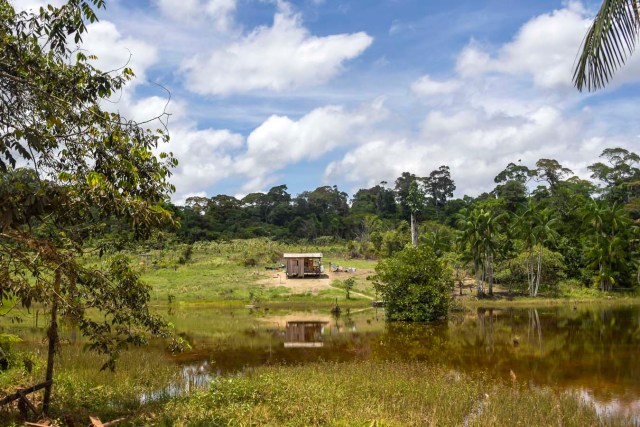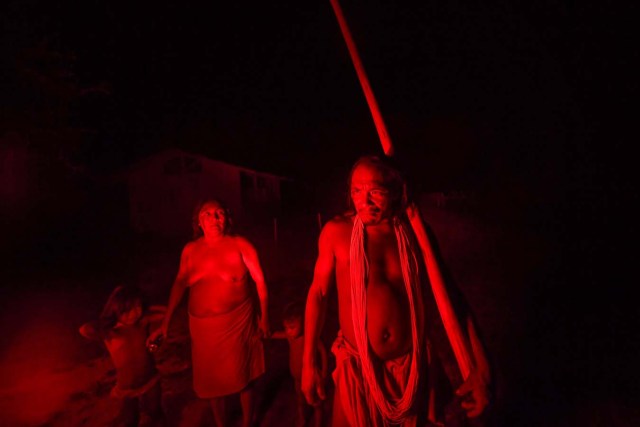
Tzako Waiapi recuerda perfectamente la primera vez que se topó con un hombre blanco mientras cazaba en la selva amazónica: a partir de ese día casi todas las personas que conocía murieron misteriosamente.
Por por Sebastian Smith / AFP
Ese encuentro a inicios de los años 1970 fue un cruce inesperado entre dos mundos, pero también el inicio de una terrible tragedia.
De un lado estaban los miembros de la tribu waiapi. Del otro, los pioneros brasileños de la implacable minería, la tala de árboles y la explotación de las riquezas naturales en la Amazonía.
Ninguno sabía de la existencia del otro.
“Los blancos sacaron sus revólveres, nosotros nuestras flechas y quedamos cara a cara”, rememora el anciano Tzako, jefe del pueblo de Manilha, en la profundidad amazónica.
El incidente terminó de forma pacífica, pero los ‘garimpeiros’ que penetraron en la selva acababan de dejar un arma mucho más letal que cualquier revólver para la tribu.
Enfermedades como el sarampión y la influenza estaban controladas hacía tiempo en las sociedades desarrolladas. Sin embargo, al propagarse entre indígenas sin ninguna inmunidad natural, esos virus se dispararon como bombas.
“Los waiapi no estábamos acostumbrados a esas enfermedades y mataron a la población rápidamente”, dice Tzako recostado en una hamaca bajo un techo de palma, rodeado de gallinas y miembros de su familia, todos ataviados con el tradicional taparrabos rojo de la tribu.
“Cuando teníamos gripe, mejorábamos, así que cuando empezó el sarampión pensábamos que también mejoraríamos. Pero el sarampión es más fuerte y algunos murieron en apenas un día”, rememora en lengua waiapi Tzako, mientras uno de sus hijos lo traduce en portugués a la AFP.
El jefe indígena no consigue recordar su edad exacta -estima que tiene unos 80 años- pero la memoria del horror que vivió cuando era joven está dolorosamente fresca.
“No quedó nadie para enterrar a los muertos. Los animales se comían los cuerpos porque no quedaban familiares para enterrarlos”, narra.
Al ser preguntado por cuánta gente cercana perdió, Tzako empieza a nombrarlos uno a uno: su mujer, su suegro y suegra, su cuñado, hijos… Pero, de repente, para de contar y ondea su mano para constatar la realidad; fueron demasiados para poder contar.
“Ellos quitaron los niños a los waiapi”, lamenta.
– “Nunca más” –
De acuerdo con un censo gubernamental, el pueblo waiapi quedó con apenas 151 miembros en 1973, muy por debajo del estimado anterior, de alrededor de 2.000.
Miembros de la tribu aseguran que había otros grupos de waiapi, tradicionalmente asentados entre Brasil y la Guayana Francesa, que escaparon de la plaga gracias a su aislamiento.
Esos sobrevivientes y un posterior programa gubernamental de vacunación ayudó a que la tribu se fuera recuperando, hasta llegar a alrededor de 1.200 miembros hoy en día. Mientras la ausencia de ancianos resulta evidente en los poblados waiapi, se ven niños por todos lados.
Ahora ya no son las enfermedades las que hacen temblar a esa tribu, sino la presión cada vez mayor del gobierno conservador brasileño y de los lobbies industriales para abrir su selva a la minería y la deforestación.
El intento fallido del presidente Michel Temer para permitir que firmas extranjeras explotaran una reserva del tamaño de Suiza en la Amazonía sembró el pánico a mediados de año.
“Estamos luchando para que eso nunca más se repita. Eso es lo que les digo a mis hijos, a mis nietos, a mi gente”, dice Tzako.
“Ahora estamos preparados para la guerra”, afirma.


Tribal chieftain Tzako Waiapi perfectly remembers the day almost half a century ago when his hunting party stumbled across a group of white adventurers in the Amazon rainforest. Within months, nearly everyone in his entire tribe had died from disease. / AFP PHOTO / Apu Gomes / TO GO WITH AFP STORY “When the Waipai tribe almost died out” by Sebastian Smith

Tribal chieftain Tzako Waiapi perfectly remembers the day almost half a century ago when his hunting party stumbled across a group of white adventurers in the Amazon rainforest. Within months, nearly everyone in his entire tribe had died from disease. / AFP PHOTO / Apu Gomes / TO GO WITH AFP STORY “When the Waipai tribe almost died out” by Sebastian Smith

Tribal chieftain Tzako Waiapi perfectly remembers the day almost half a century ago when his hunting party stumbled across a group of white adventurers in the Amazon rainforest. Within months, nearly everyone in his entire tribe had died from disease. / AFP PHOTO / Apu Gomes / TO GO WITH AFP STORY “When the Waipai tribe almost died out” by Sebastian Smith

Tribal chieftain Tzako Waiapi perfectly remembers the day almost half a century ago when his hunting party stumbled across a group of white adventurers in the Amazon rainforest. Within months, nearly everyone in his entire tribe had died from disease. / AFP PHOTO / Apu Gomes / TO GO WITH AFP STORY “When the Waipai tribe almost died out” by Sebastian Smith

Tribal chieftain Tzako Waiapi perfectly remembers the day almost half a century ago when his hunting party stumbled across a group of white adventurers in the Amazon rainforest. Within months, nearly everyone in his entire tribe had died from disease. / AFP PHOTO / Apu Gomes / TO GO WITH AFP STORY “When the Waipai tribe almost died out” by Sebastian Smith

Tribal chieftain Tzako Waiapi perfectly remembers the day almost half a century ago when his hunting party stumbled across a group of white adventurers in the Amazon rainforest. Within months, nearly everyone in his entire tribe had died from disease. / AFP PHOTO / Apu Gomes / TO GO WITH AFP STORY “When the Waipai tribe almost died out” by Sebastian Smith

Tribal chieftain Tzako Waiapi perfectly remembers the day almost half a century ago when his hunting party stumbled across a group of white adventurers in the Amazon rainforest. Within months, nearly everyone in his entire tribe had died from disease. / AFP PHOTO / Apu Gomes / TO GO WITH AFP STORY “When the Waipai tribe almost died out” by Sebastian Smith

Tribal chieftain Tzako Waiapi perfectly remembers the day almost half a century ago when his hunting party stumbled across a group of white adventurers in the Amazon rainforest. Within months, nearly everyone in his entire tribe had died from disease. / AFP PHOTO / Apu Gomes / TO GO WITH AFP STORY “When the Waipai tribe almost died out” by Sebastian Smith

